4WD MITSUBISHI L200 2004 Owner's Manual (in English)
[x] Cancel search | Manufacturer: MITSUBISHI, Model Year: 2004, Model line: L200, Model: MITSUBISHI L200 2004Pages: 264, PDF Size: 4.14 MB
Page 3 of 264
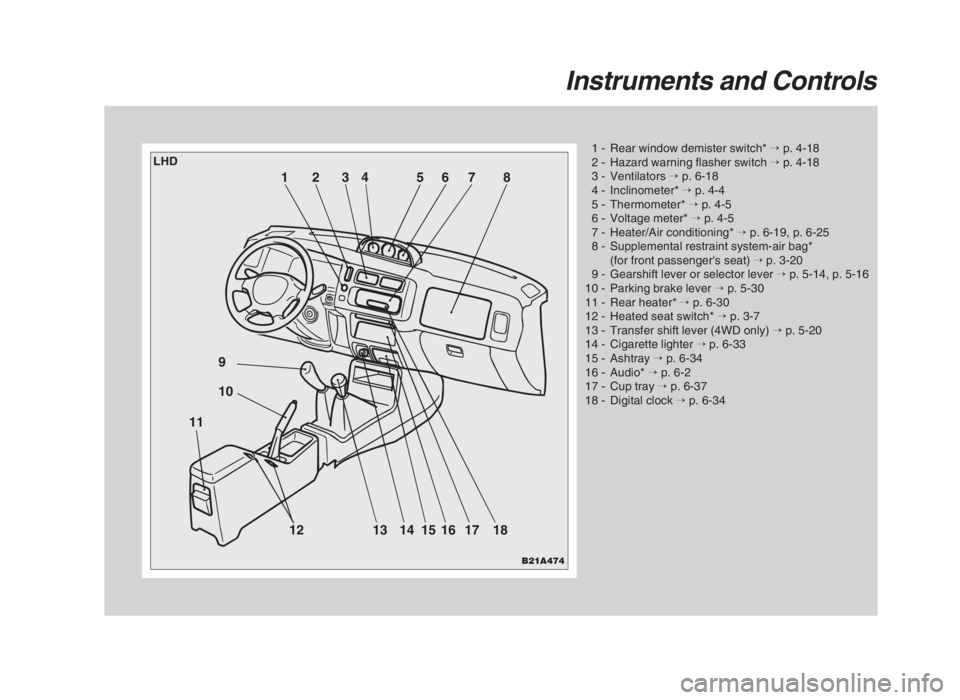
Instruments and Controls
1 - Rear window demister switch*→p. 4-18
2 - Hazard warning flasher switch→p. 4-18
3 - Ventilators→p. 6-18
4 - Inclinometer*→p. 4-4
5 - Thermometer*→p. 4-5
6 - Voltage meter*→p. 4-5
7 - Heater/Air conditioning*→p. 6-19, p. 6-25
8 - Supplemental restraint system-air bag*
(for front passenger's seat)→p. 3-20
9 - Gearshift lever or selector lever→p. 5-14, p. 5-16
10 - Parking brake lever→p. 5-30
11 - Rear heater*→p. 6-30
12 - Heated seat switch*→p. 3-7
13 - Transfer shift lever (4WD only)→p. 5-20
14 - Cigarette lighter→p. 6-33
15 - Ashtray→p. 6-34
16 - Audio*→p. 6-2
17 - Cup tray→p. 6-37
18 - Digital clock→p. 6-34
B21A474
12 9
10
11
13 14 15 16 17 18 2 1345678
LHD
01engL2_240082_4 22-01-2004 12:58 Page 1-3
Page 5 of 264

Instruments and Controls
1 - Supplemental restraint system-air bag
(for front passenger's seat)*→p. 3-20
2 - Heater/Air conditioning*→p. 6-19
3 - Ventilators→p. 6-18
4 - Voltage meter*→p. 4-5
5 - Thermometer*→p. 4-5
6 - Inclinometer*→p. 4-4
7 - Hazard warning flasher switch→p. 4-18
8 - Rear window demister switch*→p. 4-18
9 - Digital clock→p. 6-34
10 - Cup tray→p. 6-37
11 - Audio*→p. 6-2
12 - Ashtray→p. 6-34
13 - Transfer shift lever (4WD only)→p. 5-20
14 - Heated seat switch*→p. 3-7
15 - Rear heater*→p. 6-30
16 - Parking brake lever→p. 5-30
17 - Gearshift lever→p. 5-14
18 - Cigarette lighter→p. 6-33
NOTE: *1- Vehicle with electric remote-controlled outside rear-view mirrors as
optional equipment only
B21A625
1234567 8
18
17
16
15
9101112 13 14
RHD
01engL2_240082_4 22-01-2004 12:58 Page 1-5
Page 70 of 264
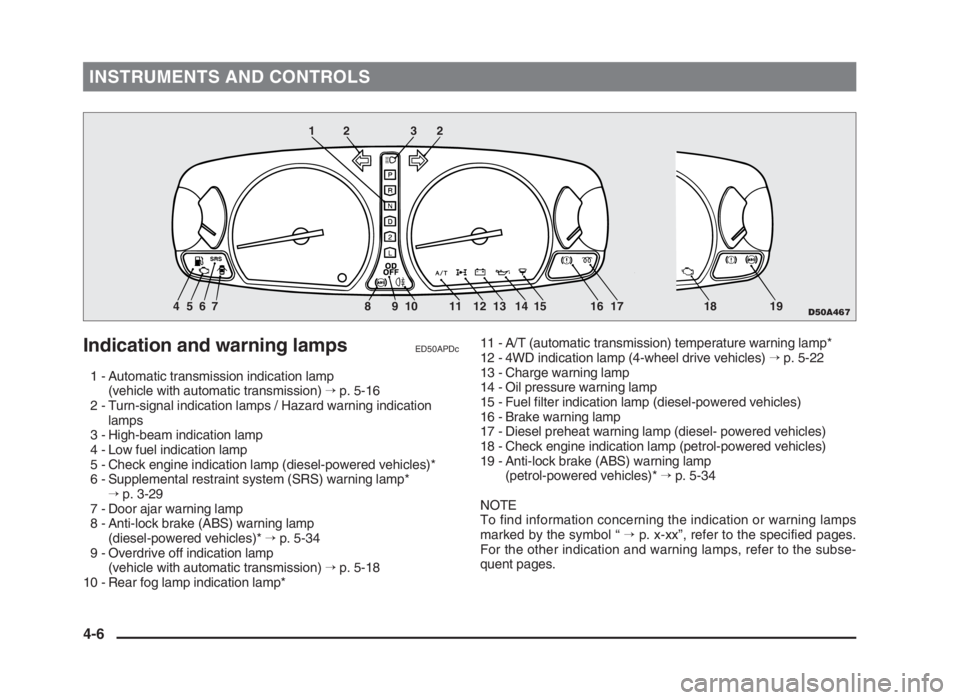
INSTRUMENTS AND CONTROLS
Indication and warning lampsED50APDc
1 - Automatic transmission indication lamp
(vehicle with automatic transmission) →p. 5-16
2 - Turn-signal indication lamps / Hazard warning indication
lamps
3 - High-beam indication lamp
4 - Low fuel indication lamp
5 - Check engine indication lamp (diesel-powered vehicles)*
6 - Supplemental restraint system (SRS) warning lamp*
→p. 3-29
7 - Door ajar warning lamp
8 - Anti-lock brake (ABS) warning lamp
(diesel-powered vehicles)* →p. 5-34
9 - Overdrive off indication lamp
(vehicle with automatic transmission) →p. 5-18
10 - Rear fog lamp indication lamp*11 - A/T (automatic transmission) temperature warning lamp*
12 - 4WD indication lamp (4-wheel drive vehicles) →p. 5-22
13 - Charge warning lamp
14 - Oil pressure warning lamp
15 - Fuel filter indication lamp (diesel-powered vehicles)
16 - Brake warning lamp
17 - Diesel preheat warning lamp (diesel- powered vehicles)
18 - Check engine indication lamp (petrol-powered vehicles)
19 - Anti-lock brake (ABS) warning lamp
(petrol-powered vehicles)* →p. 5-34
NOTE
To find information concerning the indication or warning lamps
marked by the symbol “ →p. x-xx”, refer to the specified pages.
For the other indication and warning lamps, refer to the subse-
quent pages.
4-6
D50A467
12 32
4 5 6 7 8 9 10 11 12 13 14 15 16 17 18 19
04engL2_240082_4 22-01-2004 13:19 Page 4-6
Page 78 of 264
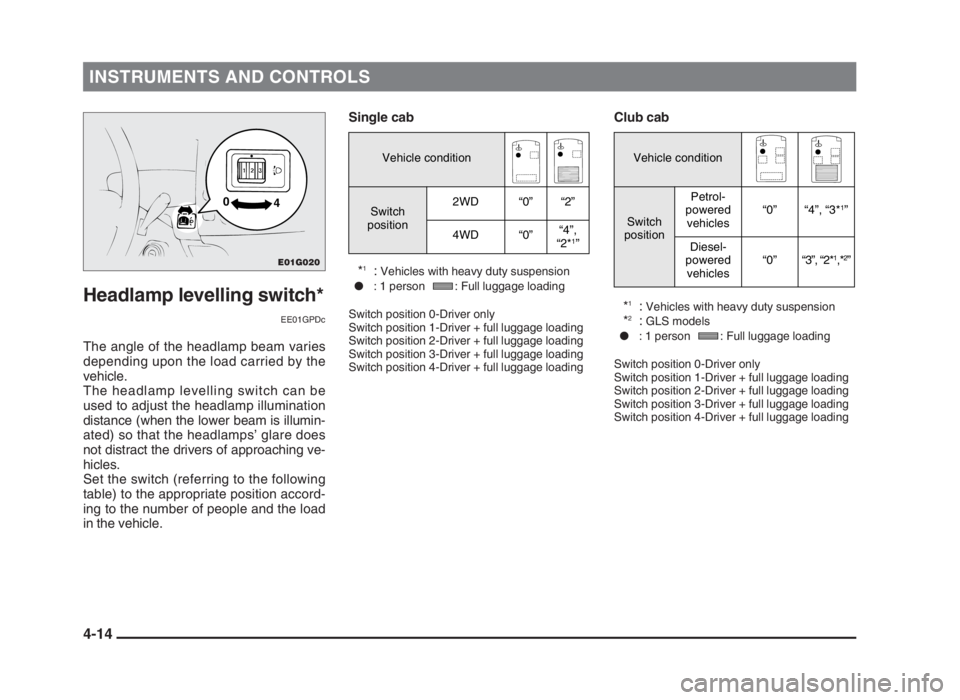
INSTRUMENTS AND CONTROLS
4-14
Club cab
*
1: Vehicles with heavy duty suspension
*2: GLS models
●: 1 person : Full luggage loading
Switch position 0-Driver only
Switch position 1-Driver + full luggage loading
Switch position 2-Driver + full luggage loading
Switch position 3-Driver + full luggage loading
Switch position 4-Driver + full luggage loading
Headlamp levelling switch*
EE01GPDc
The angle of the headlamp beam varies
depending upon the load carried by the
vehicle.
The headlamp levelling switch can be
used to adjust the headlamp illumination
distance (when the lower beam is illumin-
ated) so that the headlamps’ glare does
not distract the drivers of approaching ve-
hicles.
Set the switch (referring to the following
table) to the appropriate position accord-
ing to the number of people and the load
in the vehicle.Single cab
*
1: Vehicles with heavy duty suspension
●: 1 person : Full luggage loading
Switch position 0-Driver only
Switch position 1-Driver + full luggage loading
Switch position 2-Driver + full luggage loading
Switch position 3-Driver + full luggage loading
Switch position 4-Driver + full luggage loading
Vehicle condition
Switch
position2WD “0” “2”
4WD “0”“4”,
“2*
1
”
Vehicle condition
Switch
positionPetrol-
powered
vehicles“0” “4”, “3*
1
”
Diesel-
powered
vehicles“0” “3”, “2*
1
,*
2
”
E01G020
0
4
04engL2_240082_4 22-01-2004 13:20 Page 4-14
Page 79 of 264

INSTRUMENTS AND CONTROLS
4-15
Double cab
*
1: Vehicles with heavy duty suspension
●: 1 person : Full luggage loading
Switch position 0-Driver only
Switch position 1-Driver + full luggage loading
Switch position 2-Driver + full luggage loading
Switch position 3-Driver + full luggage loading
Switch position 4-Driver + full luggage loading
Windscreen wiper and
washer switch
EE13A-Yc
The windscreen wiper and washer can be
operated with the ignition switch in the
“ON” or “ACC” position.
Move the switch to operate the wind-
screen wipers or spray the washer fluid.
Windscreen wipers
Type 1
- Off
- Intermittent operation at intervals of
approximately 4 seconds
- Slow
- Fast
Type 2
- Off
- Intermittent operation
- Slow
- Fast
E13A035
Type 1
E13A061
Type 2
Vehicle condition
Switch position
2WD “0” “4”, “3*
1
”
4WDExcept for
GLS (A/T)
models“0” “4”, “3*
1
”
GLS
(A/T) models“0” “3”, “2*
1
”
04engL2_240082_4 22-01-2004 13:20 Page 4-15
Page 87 of 264
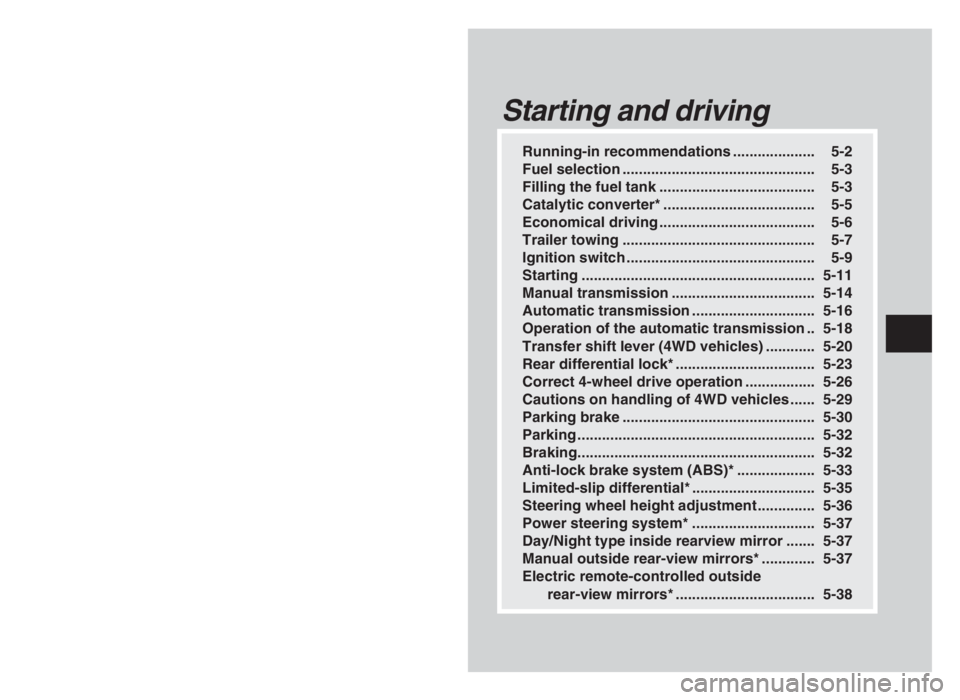
Running-in recommendations .................... 5-2
Fuel selection ............................................... 5-3
Filling the fuel tank ...................................... 5-3
Catalytic converter* ..................................... 5-5
Economical driving ...................................... 5-6
Trailer towing ............................................... 5-7
Ignition switch .............................................. 5-9
Starting ......................................................... 5-11
Manual transmission ................................... 5-14
Automatic transmission .............................. 5-16
Operation of the automatic transmission .. 5-18
Transfer shift lever (4WD vehicles) ............ 5-20
Rear differential lock* .................................. 5-23
Correct 4-wheel drive operation ................. 5-26
Cautions on handling of 4WD vehicles ...... 5-29
Parking brake ............................................... 5-30
Parking .......................................................... 5-32
Braking.......................................................... 5-32
Anti-lock brake system (ABS)* ................... 5-33
Limited-slip differential* .............................. 5-35
Steering wheel height adjustment .............. 5-36
Power steering system* .............................. 5-37
Day/Night type inside rearview mirror ....... 5-37
Manual outside rear-view mirrors* ............. 5-37
Electric remote-controlled outside
rear-view mirrors* .................................. 5-38
Starting and driving
5
05engL2_240082_4 22-01-2004 13:04 Page 5-1
Page 88 of 264
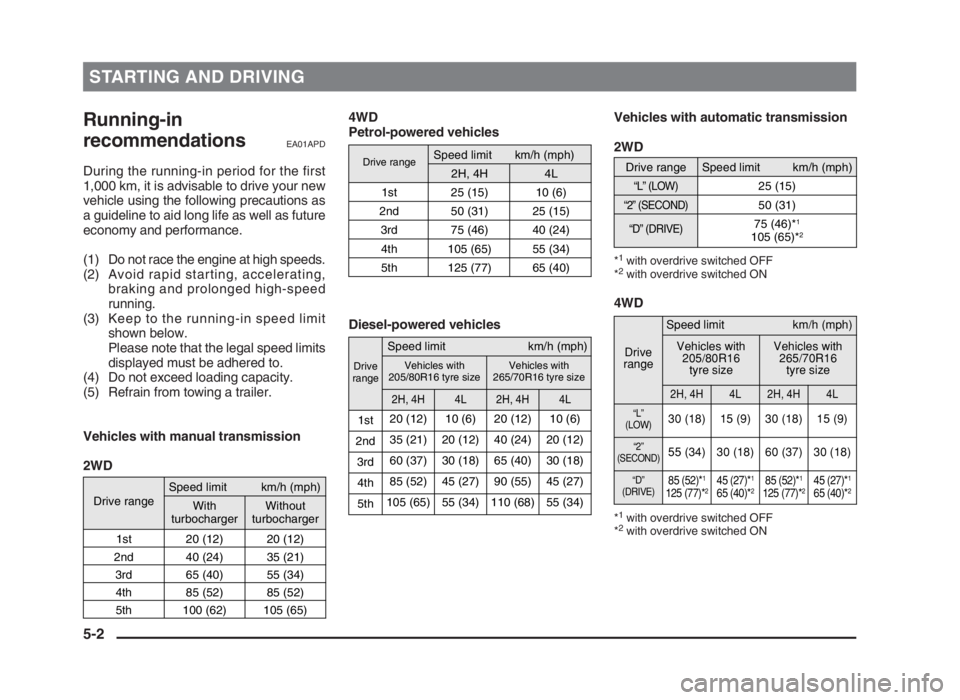
Vehicles with automatic transmission
2WD
*1with overdrive switched OFF
*2with overdrive switched ON
4WD
*1with overdrive switched OFF
*2with overdrive switched ON
STARTING AND DRIVING
Running-in
recommendations
EA01APD
During the running-in period for the first
1,000 km, it is advisable to drive your new
vehicle using the following precautions as
a guideline to aid long life as well as future
economy and performance.
(1) Do not race the engine at high speeds.
(2) Avoid rapid starting, accelerating,
braking and prolonged high-speed
running.
(3) Keep to the running-in speed limit
shown below.
Please note that the legal speed limits
displayed must be adhered to.
(4) Do not exceed loading capacity.
(5) Refrain from towing a trailer.
Vehicles with manual transmission
2WD4WD
Petrol-powered vehicles
Diesel-powered vehicles
5-2
Drive rangeSpeed limit km/h (mph)
With
turbochargerWithout
turbocharger
1st 20 (12) 20 (12)
2nd 40 (24) 35 (21)
3rd 65 (40) 55 (34)
4th 85 (52) 85 (52)
5th 100 (62) 105 (65)
Drive range
Speed limit km/h (mph)
2H, 4H4L
1st 25 (15) 10 (6)
2nd 50 (31) 25 (15)
3rd 75 (46) 40 (24)
4th 105 (65) 55 (34)
5th 125 (77) 65 (40)
Drive range
Speed limit km/h (mph)
“L” (LOW)
25 (15)
“2” (SECOND)
50 (31)
“D” (DRIVE)
75 (46)*
1
105 (65)*
2
Drive
range
Speed limit km/h (mph)
Vehicles with
205/80R16
tyre sizeVehicles with
265/70R16
tyre size
2H, 4H4L2H, 4H4L
“L”
(LOW)30 (18) 15 (9) 30 (18) 15 (9)
“2”
(SECOND)55 (34) 30 (18) 60 (37) 30 (18)
“D”
(DRIVE)85 (52)*1
125 (77)*245 (27)*1
65 (40)*285 (52)*1
125 (77)*245 (27)*1
65 (40)*2
Drive
range
Speed limit km/h (mph)
Vehicles with
205/80R16 tyre size
Vehicles with
265/70R16 tyre size
2H, 4H4L2H, 4H4L
1st20 (12) 10 (6) 20 (12) 10 (6)
2nd35 (21) 20 (12) 40 (24) 20 (12)
3rd60 (37) 30 (18) 65 (40) 30 (18)
4th85 (52) 45 (27) 90 (55) 45 (27)
5th105 (65) 55 (34) 110 (68) 55 (34)
05engL2_240082_4 22-01-2004 13:04 Page 5-2
Page 89 of 264

STARTING AND DRIVING
Fuel selectionEC20CPF
CAUTIONFor diesel-powered vehicles, fuel ad-
ditives can cause ignition compo-
nents to be damaged and never use
the fuel additives.1. Before filling with fuel, stop the en-
gine.
2. The fuel tank filler is located on the
rear left side of your vehicle.
Type 1
The fuel tank filler door can be opened
from inside the vehicle by using the fuel
tank filler door release lever located be-
side the driver’s seat.
Filling the fuel tankEC20DPF
CAUTIONGasoline is highly flammable and ex-
plosive. You could be burned or seri-
ously injured when handling it.
When refuelling your vehicle, always
turn the engine off and keep away
from flames, sparks and smoking
materials. Always handle fuel in
well-ventilated outdoor areas.
Fuel tank capacity
2WD : 69 litres
4WD : 75 litres
5-3
Recommended
fuel
Petrol-powered vehicles
Unleaded petrol octane rating
(DIN 51607)
91 RON or higher (Normal)
Diesel-powered vehicles
Cetane rating (DIN 51601)
45 or higher
C20A042
Type 1
05engL2_240082_4 22-01-2004 13:04 Page 5-3
Page 93 of 264

STARTING AND DRIVING
5-7
(1)Starting
Avoid rapid acceleration and sudden
starts; such operation will result in
higher fuel consumption.
(2)Shifting
Shift only at an appropriate engine
speed. Always use the highest gear
possible.
The transfer shift lever should be set
to “2H” when driving 4WD vehicles on
normal roads and express ways to
obtain best possible fuel economy.
(3)City traffic
Frequent starting and stopping in-
creases the average fuel consump-
tion. Use roads with smooth traffic
flow whenever possible. When driving
on congested roads, avoid use of a
low gear at high engine speeds.
(4)Idling
The vehicle consumes fuel even dur-
ing idling. Avoid extended idling
whenever possible.
(5)Speed
The higher the vehicle speed, the
more fuel consumed. Avoid driving at
full speed. Even a slight release of the
accelerator pedal will save a signific-
ant amount of fuel.Trailer towingEC21APDd
In order to tow a trailer with your vehicle,
have a trailer towing device that meets all
pertinent regulations in your area mount-
ed at an authorized MITSUBISHI dealer.
The regulations concerning the towing of
a trailer may differ from country to country.
It is recommended that you obey the regu-
lations in each area.
CAUTIONDanger of Accident!
A towing bar should be fitted by an
authorized MITSUBISHI dealer.
NOTE
Fitting of a towing bar requires specialized
skills and equipment.
Contact an authorized MITSUBISHI dealer
for details. If you are going to tow a trailer,
pay careful attention to the following
points.
(6)Tyre inflation pressure
Check the tyre inflation pressures at
regular intervals. Low tyre inflation
pressure increases road resistance
and fuel consumption. In addition, low
tyre pressures adversely affect tyre
wear and driving stability.
(7)Load
Do not drive with unnecessary articles
in the luggage compartment. Espe-
cially during city driving where fre-
quent starting and stopping is ne-
cessary, the increased weight of the
vehicle will greatly affect fuel con-
sumption. Also avoid driving with un-
necessary luggage, etc., on the roof;
the increased air resistance will in-
crease more fuel consumption.
(8)Cold engine starting
Starting of a cold engine consumes
more fuel.
Unnecessary fuel consumption is also
caused by keeping a hot engine run-
ning. After the engine is started, com-
mence driving as soon as possible.
(9)Air conditioning*
The use of the air conditioning will in-
crease the fuel consumption.
05engL2_240082_4 22-01-2004 13:04 Page 5-7
Page 95 of 264
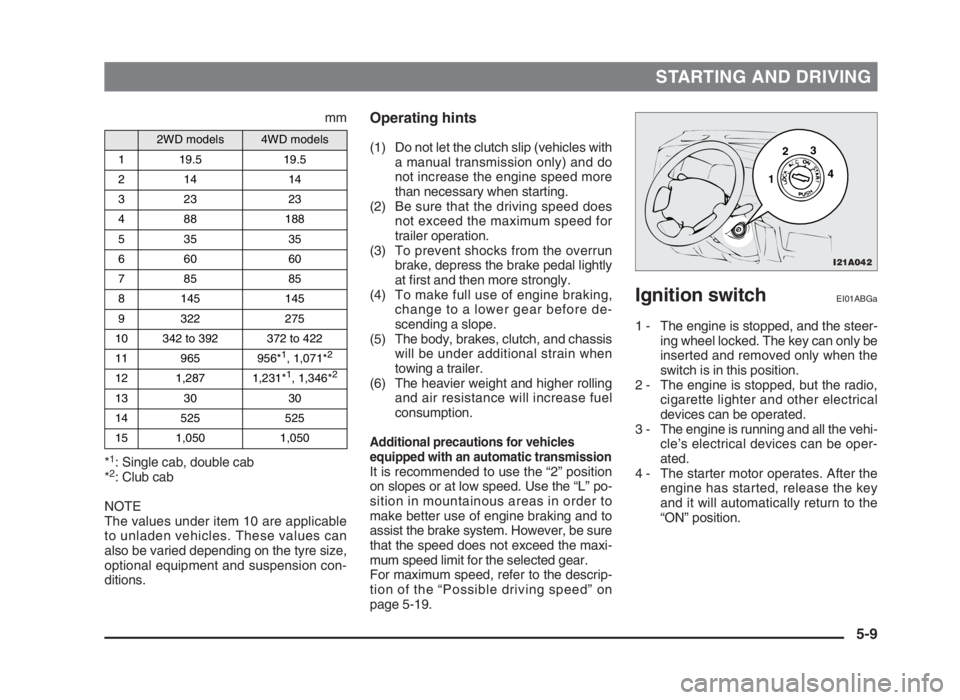
STARTING AND DRIVING
5-9
mm
*
1: Single cab, double cab
*2: Club cab
NOTE
The values under item 10 are applicable
to unladen vehicles. These values can
also be varied depending on the tyre size,
optional equipment and suspension con-
ditions.
Ignition switchEI01ABGa
1 - The engine is stopped, and the steer-
ing wheel locked. The key can only be
inserted and removed only when the
switch is in this position.
2 - The engine is stopped, but the radio,
cigarette lighter and other electrical
devices can be operated.
3 - The engine is running and all the vehi-
cle’s electrical devices can be oper-
ated.
4 - The starter motor operates. After the
engine has started, release the key
and it will automatically return to the
“ON” position.
Operating hints
(1) Do not let the clutch slip (vehicles with
a manual transmission only) and do
not increase the engine speed more
than necessary when starting.
(2) Be sure that the driving speed does
not exceed the maximum speed for
trailer operation.
(3) To prevent shocks from the overrun
brake, depress the brake pedal lightly
at first and then more strongly.
(4) To make full use of engine braking,
change to a lower gear before de-
scending a slope.
(5) The body, brakes, clutch, and chassis
will be under additional strain when
towing a trailer.
(6) The heavier weight and higher rolling
and air resistance will increase fuel
consumption.
Additional precautions for vehicles
equipped with an automatic transmission
It is recommended to use the “2” position
on slopes or at low speed. Use the “L” po-
sition in mountainous areas in order to
make better use of engine braking and to
assist the brake system. However, be sure
that the speed does not exceed the maxi-
mum speed limit for the selected gear.
For maximum speed, refer to the descrip-
tion of the “Possible driving speed” on
page 5-19.
2WD models4WD models
1 19.5 19.5
214 14
323 23
4 88 188
535 35
660 60
785 85
8 145 145
9 322 275
10 342 to 392 372 to 422
11 965 956*
1, 1,071*2
12 1,287 1,231*1, 1,346*2
13 30 30
14 525 525
15 1,050 1,050
I21A042
2
13
4
05engL2_240082_4 22-01-2004 13:04 Page 5-9